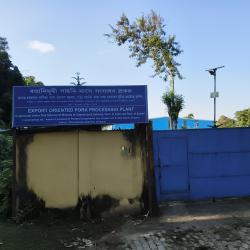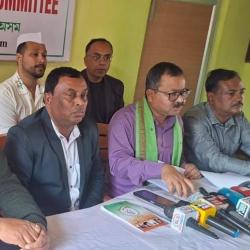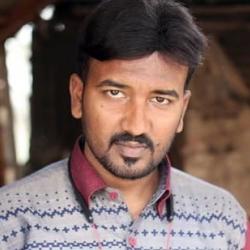I have been writing in Assamese for periodicals in my home state Assam for a long time. I grew up in Guwahati, the biggest city in India’s northeast. My early stories, the ones that I am now highly embarrassed by, were broadcast in the youth programs of All India Radio, Guwahati – India’s public radio network – when I was in secondary school. I need to mention this because, in 2004, when I moved to India’s capital Delhi to attend college, I found myself producing a completely different kind of writing from what I had done before. A couple of incidents will perhaps help illustrate the mental shift that took place in the way I thought about myself and India’s relationship with its northeastern region, including my state Assam.
On the first night in my hostel, one of my batch mates majoring in history asked me where I was from. When I replied, he said, “O yes, isn’t Assam in Arunachal, somewhere near China? There’s some terrorist activity in Assam, no?” He thought it was funny to not know about Assam, Guwahati and the northeast. But it offended me. It also made me think, because I was stunned, as I couldn’t understand how this person passed high school without knowing how to place Guwahati on the atlas - the most important city in India’s northeast. The second incident happened in 2005 when we had gone to a hill station in Himachal Pradesh on a trip from my college in Delhi. Our bus had suddenly stopped in the middle of the night on a lonely road that had forests on both sides. Many cracked jokes about “wild tribals” attacking us; everyone laughed. But the laughter had reached a new decibel when a friend of mine had said, “Don’t worry, no tribals would kill you, we aren’t in the Northeast. We are safe.” I didn’t find that statement funny. I couldn’t participate in the laughter.
This was just one of the many incidents that had provoked my mind by challenging received identities because I had grown up as an Assamese, as an Indian. I had never thought of myself as a northeastern before. It was mainland-India that imposed this identity on many of us. I do think of myself as a “northeastern” now. But then, when I was grappling with life in Delhi, these incidents changed the way I approached the things I valued: books, writing and identity. Those incidents made me recall my CBSE history textbooks, which I had grown up reading to pass exams. These were books taught all over India. I recalled, that very little about the seven northeastern states in India’s periphery was taught in the textbooks. In the chapters narrating India’s freedom struggle, the martyrs of northeast India weren’t named... What this means is that, generations of students have passed out of school since 1947 without knowing anything about India’s northeastern states, as if the people of northeast didn’t exist at all. This invisibility of the northeastern immigrant in the cultural imagination perpetuated more and more ignorance, and then, racism.
This anger in me definitely changed the way I wrote. I started writing stories and poems about the political climate of northeast. They often had long footnotes and endnotes. Now, when I think about it, I laugh. I see a young freshman student, trying to explain Assam and the northeast to the rest of India who wrote stories that provided a context to the secessionist struggle in Assam. Who did everything possible to curb the ignorance of his imagined audience in Delhi. By providing those notes, glossaries in my stories, I was probably talking to an imagined audience, who dictated the terms and conditions under which I would write. I had grown up with Assam as central to my imagination. Something so important to me was totally absent in the city where I had gone to study and often, in fact, disparaged. I wanted to leave Delhi.
This changed after I read two books that I hold close to my heart. The first book was Amitav Ghosh’s The Shadow Lines and the second was Toni Morrison’s Song of Solomon. My first few months in Delhi as an undergrad student were dismal. I really regretted my decision of taking admission in the English department. I didn’t want to study literature; I wanted to be a historian.
One of the compulsory courses in the first year of my undergrad was called “Twentieth Century Indian Writing” (and not a single writer from India’s northeast was included there). The Shadow Lines was one of the novels that we had to study. I was struck by the sheer poetry and voice of the novel. It stirred the writer inside me. I didn’t return to Assam to change my major and I believe the discovery of The Shadow Lines during the fall of 2004 was one of the reasons. Reading Song of Solomon was a delightful and different experience. I had never read anything like that. I was struck that the world of Song of Solomon was so similar to my grandmother’s village where I had spent almost all my vacations. It was a world I hadn’t ever encountered in the realm of Indian English fiction that is predominantly urban and of course, seldom set in northeast. That book as if told me that the world I held so close to my heart was worthy of literature. Above all, Toni Morrison’s novel permitted me to look at everything around from the fringes. From the perspective of a northeastern Delhi started looking different to me. I started to note things that the average Delhiite perhaps wouldn’t. Delhi appeared to have a different character when I looked at it by placing myself in Assam. I had read American writers before; but Toni Morrison’s fiction illuminated a different America for me, told me that the view changes when we look at the center from the borders. It underlined my faith in books by telling me that what is kept hidden by the world at large, could be illuminated by common human experience. Assam was alive in my mind again. At the same time, I suddenly started feeling responsible to bring into focus the Assam I had known that wasn’t present in the larger Indian imagination, and by extension, northeastern India, by writing about it.
This is the parameter I set for myself when I write fiction now: of looking at India from the periphery. If I place myself imaginatively in Delhi (or Mumbai, or New York or London) I would end up writing differently. These places would tell me to include footnotes. These cities would have asked me to essentialise Assam for the rest of India and be an interlocutor of the incomprehensible people of northeast, which isn’t the job of a storyteller. Since the culture and societies of the people in northeast is so diverse and different from the rest of India, it has largely remained incomprehensible for most of India. And perhaps, that is why, the administrators in Delhi look at northeast from a lens that only provides a distorted image. As a writer from northeast, I would like my imagination to be independent from this kind of a discourse and anxiety. As an Assamese writer, this kind of sovereignty is important for me because Assam might not be sovereign in the political sense, but its cultural and literary sovereignty should be established in its imaginative texts, especially so if one tells stories set against the Assam-India conflict – a backdrop that I can never divorce from my work.
***
Though I have used the words “peripheral” and “invisible” in the title of my talk, the northeast isn’t peripheral or invisible to me in any sense. These are modifiers outside that belong to people who describe northeast from far away. When I first started encountering these loaded phrases, I wondered – peripheral, to whom? Not me? Of course there isn’t some terrorist activity in northeast – all the bloody conflicts of northeast India have strong political contexts, back-stories. After a recent visit to Delhi in January 2011, I had started to believe things have changed because I heard from friends that many places in Delhi have landlords who happily rent out places to northeastern students, that the tolerance levels have increased. But events in the India in the last few months – Richard Loitam and Dana Sangma’s cases – have once again confirmed that the northeastern region is yet to be integrated into India’s mainstream.
I can go on citing innumerable incidents like this, yet my storehouse of examples wouldn’t be exhausted. Sometimes I wonder how different my first year in Delhi University would have been if the ‘Twentieth Century Indian Writing course’ had included at least one author from North East India in its syllabus. During those years, Indira Goswami was heading the Modern Indian Languages and Literary Studies Department of Delhi University; yet, her stories weren’t included in the syllabus of the English department of India’s premier university. If her brilliant novel The Moth Eaten Howdah of a Tusker, about the turbulent life of three high-caste widows in a religious monastery in Southern Assam, was part of the syllabus, people would have known about an Assam without the shadow of the gun, an Assam without ‘some terrorist activity’. If schools and colleges across India would have included book’s such as Temsula Ao’s Those Hills Called Home (2006) and Birendra Kumar Bhattacharya’s novel Iyaruingam (1960), people would have encountered a different image of the Naga people; they would have known about the human side of the bloody Naga Insurgency and some of my Naga friends wouldn’t have been asked by landlords in Delhi if they would kill their pet dogs and cook them for dinner. In 2007, a friend from Arunachal told me how stressful her years in Delhi were as a student in a Medical college. Often, her classmates would joke about the ‘savage tribes’ of northeast; once, her teacher said, ‘in India, people run away from snakes, but in northeast, people run after snakes: to eat.’ I wonder if her years in Delhi would have been better if her classmates had read Lumer Dai’s classic novel The Laughter of the Earth (1963) as their rapid reader in high-school. Reminiscent of Chinua Achebe’s Things Fall Apart (1958), this novel talks about the Adi tribe’s complex entry into modernity through a set of memorable characters and crumbling of the Village Council called Kebang.
What I am trying to say is that one of the most important mediums of connecting different cultures is fiction. More we read about a certain people, community, and nation through their fiction, closer and clearer they become for us. I moved to the United States very recently but I already had diverse ideas and expectations of Americans because I read American fiction so often. I knew about the American South from Faulkner, California from Steinbeck, about Native Americans from Leslie Marmon Silko, and Chinese-Americans from Maxine Hong Kingston. Having grown up reading and re-reading the works of Indira Goswami, Delhi was so familiar to me. One of the novels that had captured my imagination in high school is Ejon Eshwaror Sondhanot by Anuradha Sharma Pujari; its first part evocatively captures the lives of students in Delhi and for a long time, I wanted to find out the hostel in Mukherji Nagar that she describes so wonderfully. If students all over India read the novels and short stories by Easterine Iralu, Jahnvai Barua, Mitra Phukan, Anjum Hasan, Mamang Dai, Reeta Chowdhruy, Arupa Patangia Kalita, at different stages of their academic career, they would perceive northeasterns as ‘people’; not as exotic beings; wouldn’t dismiss the political struggles for self-determination as ‘anti-India’, ‘some-terrorist-activity’ but approach with empathy and respect.
What is most fascinating that most of the authors I have mentioned here, do not write with a sense of regret or bitterness though their fiction emerges from a very violent and brutally exploited region. Though India has a tenuous relationship with its northeastern states this fraught bonding seeps into the fiction of this region in complex ways and as if stresses that fiction isn’t a place for confrontation, but of integration, of connection. In fact, I believe, anger is a tiny and insignificant emotion to write from.
As a writer from Assam, I also aspire to do the same. I take great pleasure in the in the Assamese experience, despite the continuing horrific bloodshed and appalling injustice and exploitation back home, despite the fact that it lies in the peripheries of India’s political, cultural and literary imagination and it is hard work to write about such a place.
I would like to end with a quote by Toni Morrison—the most important writer to me, in whose career and work—I find answers to all my doubts. I think, in India’s northeast, especially in Assam, this is exactly what the authors are doing and it is significant because they are doing it despite such duress: “My project rises from delight, not disappointment. It rises from what I know about the ways writers transform aspects of their social grounding into aspects of language, and the ways they tell other stories, fight secret wars, limn out all sorts of debates blanketed in their text. And rises from my certainty that writers always know, at some level, that they do this.” (“Black Matters”, Playing in the Dark: Whiteness and the Literary Imagination.)
(This article is the edited transcript of a speech delivered by the writer at City University of New York, on May 19, 2012. © Aruni Kashyap)
Here's the recorded talk:
- Add new comment
- 12467 reads










Comments
Add new comment